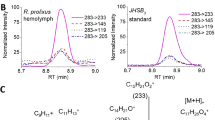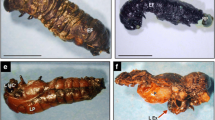Summary
Three juvenile hormone analogs (JHA), an acyclic terpene (ACT) [ethyl-3,7,11-trimethyldodeca-2,4-dienoate], a non-terpenoid compound (NT) [acetaldehyde-2-(2-ethoxyethoxy)-ethyl-4-(methylthio)-m-tolyl acetal], and an aromatic terpenoid ether (ATE) [1-(4-ethylphenoxy)-6,7-epoxy-3,7-dimethyl-2-octene] were studied to determine their effect on the embryonic development ofHyalomma (H.) dromedarii. ACT completely blocked embryonic development of eggs that had not yet reached the vitellogenesis stage or were in this stage at the time of ACT application to the female. Development of eggs between vitellogenesis and ovulation stages was partially blocked. Embryogenesis was more or less blocked by NT and ATE, except in a few egg batches from females that had received high NT doses. F1 larval mortality after JHA application to parent females was 100% with ACT, 5 to 100% with NT, and 5 to 85% with ATE.
Similar content being viewed by others
References
Bagley, R. W., Bauernfeind, J. C.: Field experiences with juvenile hormone mimics. In: Menn and Beroza (eds.), Insect juvenile hormones chemistry and action, p. 113–151. New York and London: Academic Press 1972
Bassal, T. T. M., Hefnawy, T.: Biochemical and physiological studies of certain ticks (Ixodoidea). The effect of unfed female weight on feeding and oviposition ofHyalomma (H.) dromedarii Koch (Ixodidae). J. Parasit.58, 984–988 (1972)
Bassal, T. T. M., Roshdy, M. A.:Argas (Persicargas) arboreus: Juvenile hormone analog termination of diapause and oviposition control. Exp. Parasit.36, 34–39 (1974)
Baumann, G.: Zur Wirkung der Juvenilhormone: Elektrophysiologische Messungen an der Zellmembran der Speicheldrüse vonGalleria mellonella. J. Insect Physiol.14, 1459–1476 (1968)
Baumann, G.: Juvenile hormone: effect on bimolecular lipid membranes. Nature (Lond.)223, 316–317 (1969)
Bull, D. L., Ridgway, R. L., Buxkemper, W. E., Schwartz, M., McGovern, T. P., Sarmiento, R.: Effects of synthetic juvenile hormone analogs on certain injurious and beneficial arthropods associated with cotton. J. Econ. Ent.66, 623–626 (1973)
Dhanda, V.: Changes in neurosecretory activity at different stages in the adultHyalomma dromedarii Koch. Nature (Lond.)214, 508–509 (1967)
Khalil, G. M.: Biochemical and physiological studies of certain ticks (Ixodoidea). Gonad development and gametogenesis inHyalomma (H.) anatolicum excavatum Koch (Ixodidae). J. Parasit.56, 596–610 (1970)
Kitaoka, S.: Effects of ecdysones on ticks, especially onOrnithodoros moubata (Acarina: Argasidae). In: Abstracts 14 Internat. Congr. Entom., p. 272. Canberra (August, 1972)
Menn, J. J., Beroza, M.: Insect juvenile hormones chemistry and action, pp. 341. New York and London: Academic Press 1972
Riddiford, L. M.: Juvenile hormone and insect embryogenesis. Bull. Soc. Ent. Suisse44, 177–186 (1971)
Roshdy, M. A., Shoukrey, N. M. K., Coons, L. B.: The subgenusPersicargas (Ixodoidea, Argasidae,Argas). 17. Neurohemal organ inA. (P.) arboreus Kaiser, Hoogstraal and Kohls. J. Parasit.59, 540–544 (1973)
Schneiderman, H. A.: The strategy of controlling insect pests with growth regulators. Bull. Soc. Ent. Suisse44, 141–149 (1971)
Sláma, K.: Insect juvenile hormone analogues. Ann. Rev. Biochem.40, 1079–1102 (1971)
Wigglesworth, V. B.: Chemical structure and juvenile hormone activity: Comparative tests onRhodnius prolixus. J. Insect Physiol.15, 73–94 (1969)
Wright, J. E.: Hormonal termination of larval diapause inDermacentor albipictus. Science163, 390–391 (1969)
Author information
Authors and Affiliations
Additional information
From Research Project MF51.524.009-0055, Bureau of Medicine and Surgery, Department of the Navy, Washington, D.C. The opinions and assertions contained herein are the private ones of the author and are not to be construed as official or as reflecting the views of the Department of the Navy or of the naval service at large. This study was assisted by Agreement 03-016-1 between the National Institute of Allergy and Infectious Diseases (National Institutes of Health) and NAMRU-3.
Rights and permissions
About this article
Cite this article
Bassal, T.T.M. Biochemical and physiological studies of certain ticks (Ixodoidea). Activity of juvenile hormone analogs during embryogenesis inHyalomma (H.) dromedarii Koch (Ixodidae). Z. Parasitenk. 45, 85–89 (1974). https://doi.org/10.1007/BF00636529
Received:
Issue Date:
DOI: https://doi.org/10.1007/BF00636529




